Supplemental digital content is available in the text.
Abstract
SIGNIFICANCE
We investigated, for safety and awareness, ultraviolet and high-energy violet light–blocking protection provided by assorted types of eyewear. Ultraviolet and high-energy violet light–filtering efficiency varied and did not correlate with price or advertised claims. Standardization of methods and specifications for lens spectral transmission evaluation is recommended.
PURPOSE
Studies have linked exposure of high-energy visible blue light to effect and damage on retinal epithelial cells, photoreceptors, and ganglion cells. “Blue light” is more accurately differentiated into “high-energy visible blue-violet light” and “circadian rhythm blue-turquoise light.” This study measured and compared spectral transmission of ultraviolet and high-energy violet light of low-, medium-, and high-priced sunglasses.
METHODS
Sunglasses and lens blanks were obtained from the University of Texas Medical Branch Optical Shop and vendors. Groups were based on promotional, retail, designer sunglasses, or “blue blocker” lenses. The percent transmittance of ultraviolet/visible spectral scans (800 to 350 nm) was measured using an Agilent Cary 50 spectrophotometer. High-energy violet/blue light was defined as 400 to 450 nm.
RESULTS
Promotional sunglasses (tinted polycarbonate) blocked 100% ultraviolet and 67 to 99.8% high-energy violet blue light. Retail sunglasses filtered out 95 to 100% ultraviolet A and 67% high-energy violet light. The tested designer sunglasses varied widely in their optical transmissibility with respect to their ultraviolet A and high-energy violet light–blocking properties, with some not blocking ultraviolet A. Clear and colorless Kodak Total Blue provided maximal high-energy violet protection, whereas clear Essilor Crizal Prevencia provided less high-energy violet blocking between 400 and 450 nm.
CONCLUSIONS
The ultraviolet and high-energy violet (400 to 450 nm) light–filtering efficiency varied between sunglasses and clear lenses and did not correlate with price or advertised claims. Standardization of methods and specifications for lens spectral transmission evaluation is recommended.
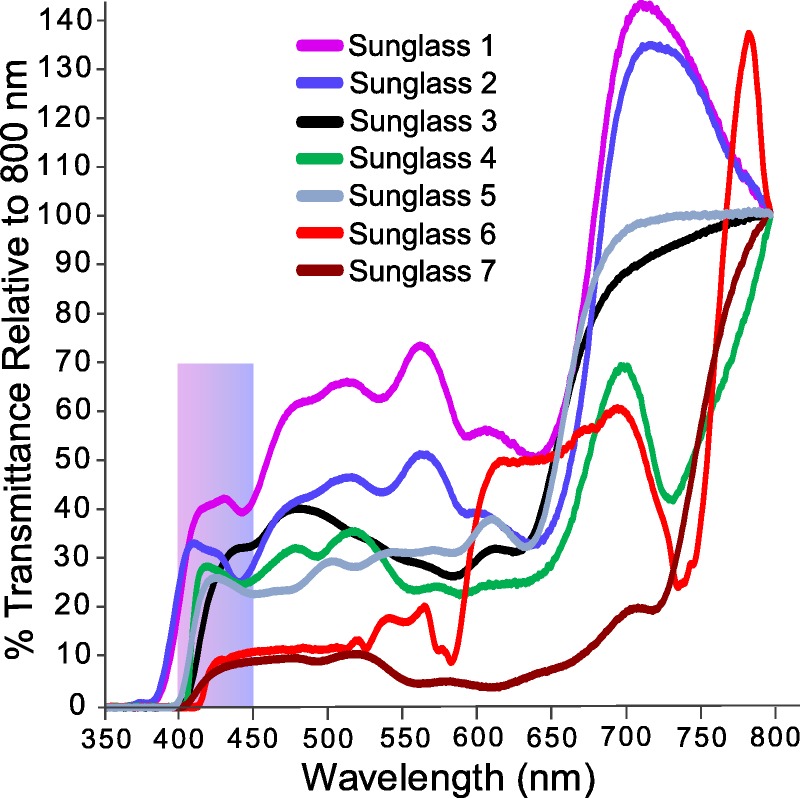
Long-term sunlight exposure is known to be associated with the development of skin cancer, skin aging, immune suppression, and eye diseases such as cataracts and age-related macular degeneration.1,2 For decades, it has been established that ultraviolet radiation ranging from 100 to 400 nm is harmful to the retina, whereas the visible spectrum of light from 400 to 700 nm is relatively safe.3–5 Ultraviolet light is electromagnetic radiation with wavelengths ranging from 100 to 400 nm. The earth's atmosphere absorbs almost all of ultraviolet C (100 to 280 nm) and most of ultraviolet B (280 to 315 nm) light. Ultraviolet A (315 to 400 nm), visible light (380 to 760 nm), and infrared (>760 nm) are able to reach the earth's surface.6
Three critical ocular structures are affected by ultraviolet exposure: the cornea, the lens, and the retina. The cornea transmits radiant energy only at 295 nm or greater. The crystalline lens absorbs almost all incident energy to wavelengths of nearly 400 nm. In youth, a very small amount of ultraviolet A reaches the retina, but the lens becomes more absorbing with age.7 The absorptive characteristics of the human lens vary drastically with age. The young lens absorbs primarily ultraviolet A, whereas with age, there are increases in absorptions at 320 nm and out to wavelengths as long as 550 nm.8 The cornea is responsible for absorbing and filtering the shortest and thus most energetic ultraviolet radiation (ultraviolet C, <280 nm). For radiation that penetrates through the cornea, the aqueous humor absorbs a moderate amount of light between 280 and 360 nm, as well as light in the long infrared range (1200 to 2300 nm). This combination with pupillary constriction narrows the spectrum and decreases irradiance onto the intraocular tissues.9 In phakic eyes, the cornea is the dominant ultraviolet B–protective filter, and the lens is the dominant ultraviolet A filter of the retina.10 Thus, there are intraocular filters that effectively filter different parts of the ultraviolet spectrum and allow only of the order of 1% or less to actually reach the retina.7 However, studies are now emerging to show that the so-called nonharmful visible light spectrum of light can also cause retinal injury via photochemical damage.
Chronic exposure to short-wavelength blue light, known as “high-energy visible” light, can potentiate harmful effects on retinal epithelial cells,11,12 photoreceptors,13,14 and ganglion cells.15 Much of this work has been done in vitro, in cell cultures, and at intensities and/or exposure durations that are much greater than the typical person is expected to experience. These results show that there are ocular effects from blue light, but the in vitro results may not fully translate to real-world conditions. However, recent in vivo studies have examined retinal damage from blue light in rats and mice,16–18 and human clinical experience is being reviewed and reported.19,20
Blue light is a range of the visible light spectrum, generally recognized as having a wavelength between 400 and 495 nm. Typical descriptions of hue are violet for 400 to 450 nm; blue, near 470 nm; and blue green, 480 to 495 nm.21 The shorter wavelengths, those between 400 and 450 nm, have more energy, with 400 to 425 nm having the highest level of energy.
In 2013, researchers with Essilor of America, Inc., and the Paris Vision Institute, studying narrow bands of wavelengths, found that blue-violet light was the most harmful to porcine retinal pigment epithelium cells, as it caused the most cell death.22 The Beaver Dam Eye Study, a population-based cohort study, measured the amount of sunlight exposure and incidence of age-related macular degeneration in 2764 subjects during a 10-year period.23 They found that extended sunlight exposure was associated with higher incidence of early age-related macular degeneration. However, the protective effect of sunglasses was only marginal, and the data were reported on a subjective basis.24 Subsequent studies have shown protective benefits of high-energy violet light blocking.25–30
Age-related macular degeneration may be attributed to accumulated oxidative stress over time.12 This oxidative stress is due to a cumulative effect of the following factors: ultraviolet and high-energy visible light generating free radicals (also known as reactive oxygen species), more retinal exposure to high-energy violet light in ages 1 to 40 years, and increased exposure to high-energy visible light from electronic devices. The combination of blue light exposure from sunlight and low plasma concentrations of antioxidants has been found to be associated with the early stages of age-related macular degeneration, which are common in the population, and that blue light exposure in middle age might be more damaging than that in younger ages.31
Blue light is more accurately differentiated into “high-energy visible blue-violet light” (400 to 450 nm) and “circadian rhythm blue-turquoise light” (460 to 470 nm).32–35 The spectral sensitivity of acute melatonin suppression, a marker of the circadian clock, ranges from 447 to 484 nm36 and peaks close to 460 nm.37 Light exposure and chronodisruption have been reviewed by Bonmati-Carrion et al.38 In addition, a recent review of clinical studies shows that a 2-hour exposure to light (460 nm) in the evening suppresses melatonin. The maximal melatonin suppressing the effect of light exposure is achieved at the shortest wavelengths (424 nm). Melatonin concentration recovers, however, rather rapidly, within 15 minutes from cessation of the exposure. This suggests a short-term or simultaneous impact of the light exposure.39
The useful range for color vision in humans is approximately 450 to 650 nm. High-energy visible light is high-frequency, high-energy light in the violet-blue band of the visible spectrum from 400 to 450 nm. High-energy visible light is found in sunlight as well as in artificial light sources such as fluorescent and light-emitting diode lighting, smartphones, tablets, laptops, televisions, and many other electronic devices. Several comprehensive reviews have described and detailed ocular phototoxicity both from sunlight and from artificial lighting.3,40–42 Epidemiological studies have also correlated sunlight exposure with early stages of macular degeneration.23,43 In addition, short-wavelength light is considered to be the most harmful light of the visible spectrum because it generates reactive oxygen species leading to pathogenesis of retinal diseases such as age-related macular degeneration.44
Ideally, a good portion of the ultraviolet radiation is filtered by the ocular structures, leaving only a small amount to reach the retina. However, the so-called blue light reaches the retina if not obstructed by any optical devices. Early studies of protective eyewear for psoralen and ultraviolet A therapy, focusing on ultraviolet and visible light, were conducted by Moseley45 and Moseley et al.46 in the 1980s. Reichow et al.47 reviewed some of the physical and spectral characteristics that eyewear (retail and designer) should have to protect the wearer from ultraviolet and high-energy violet light. In 2016, Chorley et al.48 studied sunglass protection for civilian pilots and found that lenses manufactured to minimally comply with standards for ultraviolet transmittance could result in excess ultraviolet exposure to a pilot based on in-flight irradiance data. Ophthalmic devices and intraocular implants do filter out broadband of ultraviolet/visible blue light unselectively, thus inducing unwanted effects on circadian rhythm or color perception. Because there exists limited information of specific wavelength filtering mechanisms, in many of such devices, people often rely on expensive eyewear thinking that they are more efficient in blocking the harmful short-wavelength light spectra.
The present study investigates the optical transmissibility of representative low-, medium-, and high-priced sunglasses, as well as clear, colorless eyewear and lenses to assess the spectral wavelength cutoff. Our interests were to determine the high-energy violet light–protective capability of sunglasses in general and to test if expensive sunglasses were superior in ultraviolet and high-energy violet light protection compared with less expensive models. We also had the opportunity to test “blue blocker” lenses, as well as clear-coated lenses, marketed for high-energy violet light blockage, and evaluated them relative to their attenuation characteristics for the short-wavelength light visible light. We intentionally focused on the high-energy violet light wavelength range of 400 to 450 nm, as it carries high-energy frequency and can potentiate a detrimental disruption of cellular structure.
METHODS
Sunglasses and lens blanks were obtained from the University of Texas Medical Branch Optical Shop and outside vendors (n = 28). Details were taken from each pair of sunglasses or lens blank, including manufacturer, model, and details of whether the lenses were polarized or have antireflective coating and suggested price (Table 1). Promotional sunglasses were obtained from Hitpromo.net (Largo, FL). The sunglasses and lenses were divided into five separate groups, as shown hereinafter. Each group represented a particular price category of sunglasses or lens of interest and was recorded as low-, medium-, or high-priced sunglasses; lens blank; or blue blocker lenses. An additional group, group 6, compared lens data collected from the previous groups that are clear and may be used indoors and for electronic device viewing.
TABLE 1.
List of sunglasses and lenses tested
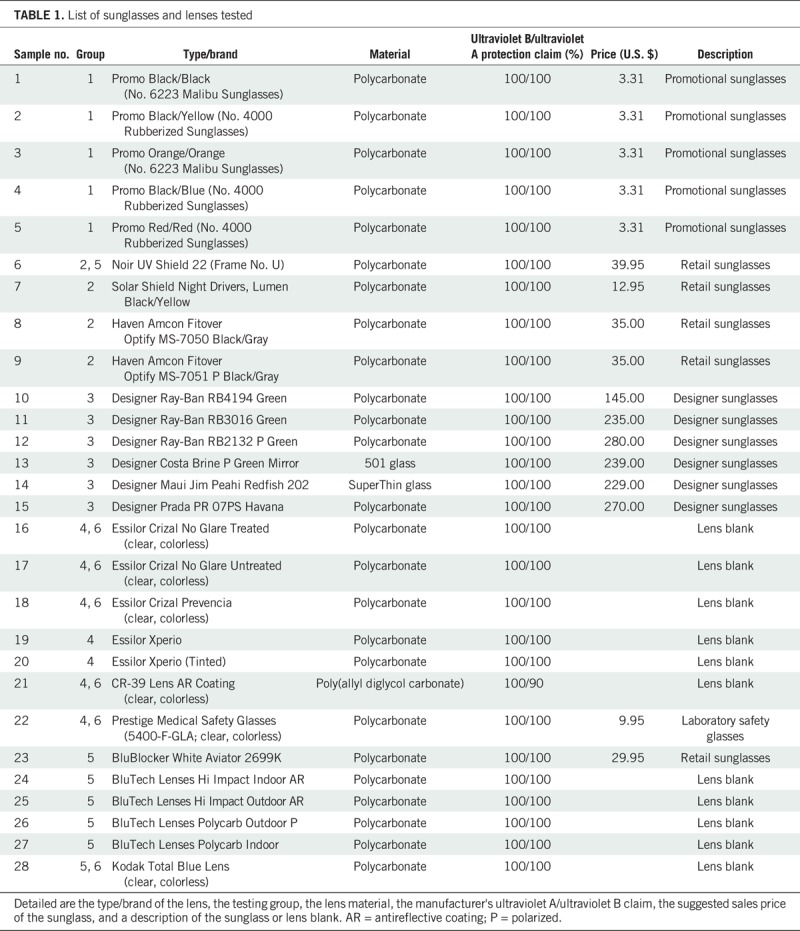
Group 1: low price (promotional sunglasses, free, $3.31)
Group 2: medium price (retail sunglasses, $10 to 40)
Group 3: high price (designer sunglasses, $200 to 350)
Group 4: lens blanks (demo and display lenses)
Group 5: blue blocker lenses (designed to filter blue light)
Group 6: clear, colorless lenses
Spectral transmission through the sample lenses was measured using an Agilent Cary 50 spectrophotometer (Varian, Mulgrave, Victoria, Australia) adapted to provide a positioning stage within the light beam pathway. A stage/mounting bracket was used so that the lens material was perpendicular to the beam path. The bracket provided a uniform distance between the light source and the light sensor, with the ability to measure three distinct positions on the lens. Spectrophotometer baseline correction was performed from 800 to 350 nm to negate the spectrophotometer transmission error measurements throughout the test range. Transmission normalization to 100% transmission (0% absorption) was performed at 800 nm on each lens before each measurement to normalize the neutral density filtering characteristics of each lens to allow for lens-to-lens comparison in the range of interest. Spectral scans were taken from 800 to 350 nm with data collection points at every 1.0 ± 0.13 nm. Each lens was scanned at three separate, individual points on the lens surface, and the results were averaged for that lens. Comma-separated value data files were recorded and imported to Microsoft Excel (Microsoft Corporation, Redmond, WA) to prepare spectral scan graphs for comparison. Results are reported as percent transmission wherein 100% transmission corresponds to absorption of 0.00 optical density.
RESULTS
The percent spectral transmission data were obtained from spectrophotometer scans and are reported between wavelengths 400.03 and 449.98 nm. Appendix Table 1 (Supplemental Digital Content, available at http://links.lww.com/OPX/A405) shows these data, for the sake of brevity, at every 1.99 ± 0.0566-nm increment for each group as described in METHODS. Each lens, having been scanned at three separate, individual points on the lens surface, showed a variation of standard deviation of ±0.4% or less. Five promotional sunglasses, sourced from the same vendor, are shown in Supplemental Digital Content, Appendix Table 1, as individual scans and as an average with standard deviation. The wavelengths, 400 to 450 nm, are high-energy violet light that presents the greatest risk to ocular tissue. This spectral range is also emphasized as a shaded area in the following figures.
Group 1: Promotional Sunglasses
Five promotional sunglasses (samples 1 to 5, shown in Fig. 1) were scanned from 800 to 350 nm. All five of the tested sunglasses essentially blocked 100% of ultraviolet light up to 400 nm and filtered an average of 72.5% (±6.1%) of the high-energy violet light at 426 nm, with a decreasing gradient to blocking of approximately 67.0% (±11.5%) of the high-energy violet light at 450 nm.
FIGURE 1.
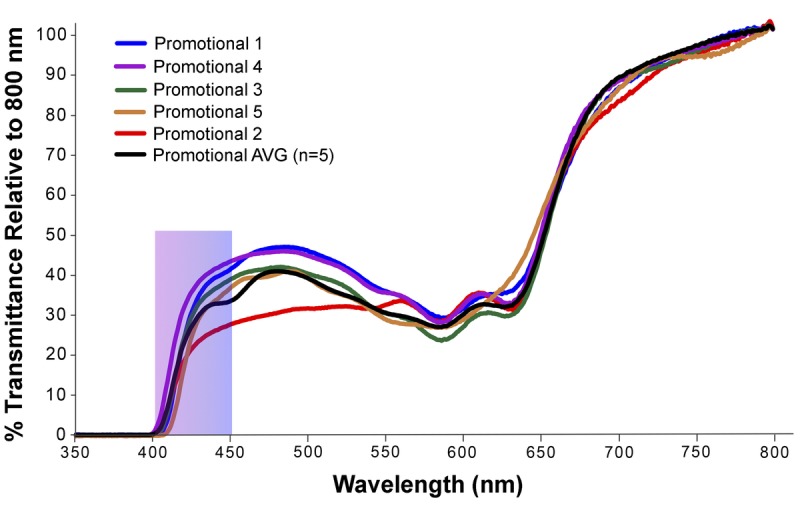
Ultraviolet/visible spectrophotometric scans comparing the percent transmission of group 1 (low-cost promotional sunglasses). The average of the five scans is shown in black. The wavelengths, 400 to 450 nm, are high-energy violet light that presents the greatest risk to ocular tissue. This spectral range is emphasized as a shaded area.
Group 2: Retail Sunglasses
In group 2, the four retail sunglasses tested blocked approximately 95 to 100% of the ultraviolet light with much improved high-energy violet light–filtering capability when compared with the promotional sunglasses on average (Fig. 2). Although the Solar Shield Night Drivers (FGX International, Smithfield, RI) provided the best protection for harmful light blocking, surprisingly it failed to block 100% of the ultraviolet light, with 0.19% transmittance at 389 nm, increasing to 5.6% transmittance at 400 nm. When noted for the 400- to 426-nm range, the Solar Shield lenses were fairly stable to block high-energy violet light, ranging from 94.4 to 86.2%, respectively. Also observed was that the Haven Optify MS-7050 (FGX International) and the Noir UV Shield 22 (Noir Medical, South Lyon, MI) provided 100% ultraviolet light blockage and performed similarly in the high-energy violet range of 426 nm, blocking 81.7 and 73.9%, respectively. At 450 nm, the Noir UV Shield 22 blocked 64.2%, Solar Shield Night Drivers blocked 82.5%, Haven Optify MS-7050 blocked 75.4%, and Haven Optify MS-7051 P blocked 62.8%.
FIGURE 2.
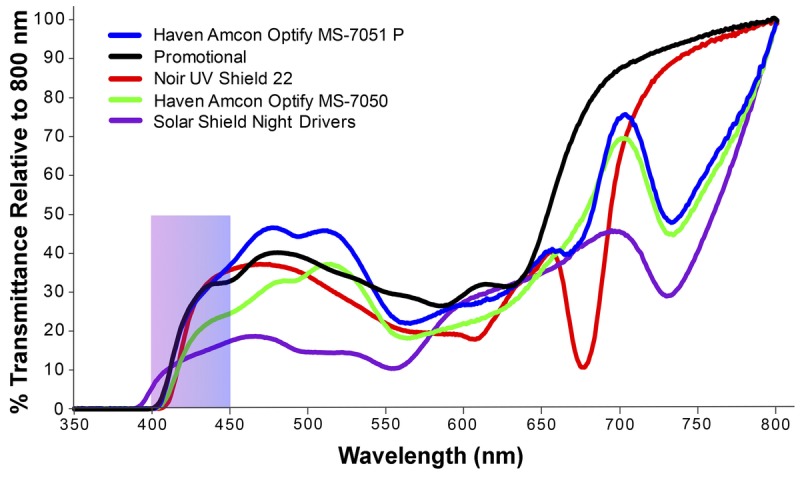
Ultraviolet/visible spectrophotometric scans comparing the percent transmission of group 2 (medium-cost retail sunglasses). The average of group 1 (low-cost promotional sunglasses), shown in black, is added for comparison. The wavelengths, 400 to 450 nm, are high-energy violet light that presents the greatest risk to ocular tissue. This spectral range is emphasized as a shaded area.
Group 3: Designer Sunglasses
As depicted in Fig. 3, expensive designer sunglasses varied widely in their optical characteristics of their ultraviolet and high-energy violet light attenuation. Of interest, the percent transmission of the Costa Brine P (Costa, Daytona Beach, FL) and Maui Jim Peahi Redfish (Maui Jim Lahaina, HI) showed the greatest protection, blocking out 100% ultraviolet A and approximately 94% high-energy violet light at 418 nm and a little more than 90% high-energy violet light at 426 nm. Ray-Ban RB2132P (Ray Ban, Luxottica Group, Milan, Italy) blocked ultraviolet A light but did not block wavelengths of 403 nm and greater. To our surprise, the remainder of the designer sunglasses did not absorb either ultraviolet A or high-energy violet light efficiently. Of note, Ray-Ban RB4194 and Ray-Ban RB3016 transmitted wavelengths of 380 nm and greater, and Ray-Ban RB2132P and Prada PR 07PS Havana (Luxottica Group) blocked only 73% high-energy violet light when measured at 426 nm. At 450 nm, Ray-Ban RB4194 blocked only 57.4%, Ray-Ban RB3016 blocked 70.7%, Ray-Ban RB2132P blocked 74.1%, Costa Brine P blocked 88.9%, Maui Jim Peahi Redfish blocked 90.7%, and Prada PR 07PS Havana blocked 77.0%.
FIGURE 3.
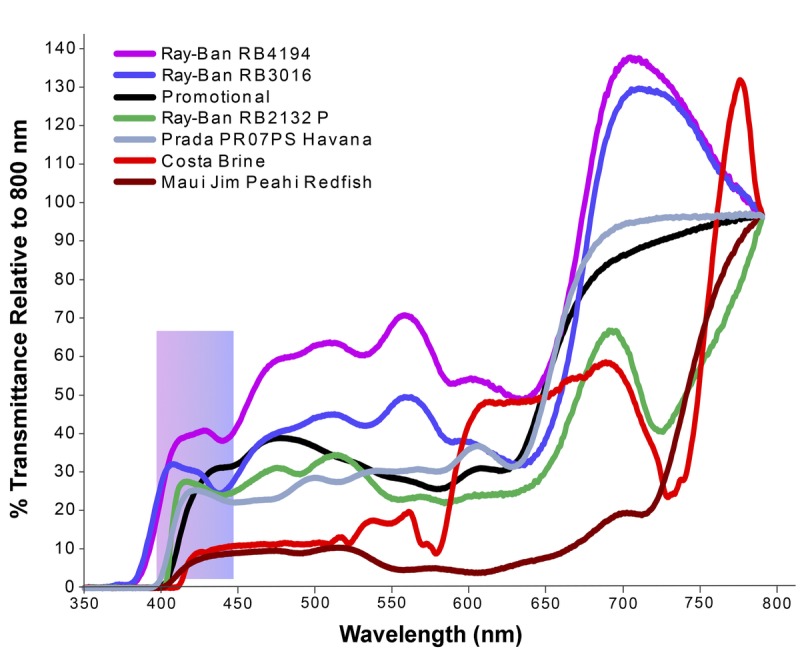
Ultraviolet/visible spectrophotometric scans comparing the percent transmission of group 3 (high-cost designer sunglasses). The average of group 1 (low-cost promotional sunglasses), shown in black, is added for comparison. The wavelengths, 400 to 450 nm, are high-energy violet light that presents the greatest risk to ocular tissue. This spectral range is emphasized as a shaded area.
Group 4: Lens Blanks Series
The percent transmissions of spectral scans of clear and demo/display lens blanks are shown in Fig. 4. Essilor Crizal No Glare (clear, treated, and untreated; Essilor of America, Inc., Dallas, TX) and CR-39 display lenses showed minimal blocking of ultraviolet light (54.7 to 58.7% transmittance at 380 nm and 90.7 to 96.8% transmittance at 400 nm). There was also minimal blocking of high-energy violet light (90 to 100% transmittance) at wavelengths of 400 to 426 nm. This was expected because the lenses were only demonstrating no-glare or antireflective coatings. The Prestige Medical Safety Glasses (laboratory safety glasses; Prestige Medical, Northridge, CA) did not block ultraviolet or high-energy violet light effectively either. Essilor Xperio Tinted lenses blocked 100% ultraviolet and 99.9 to 73.1% high-energy violet light between 400 and 426 nm, similar to the promotional sunglasses. However, the Essilor Xperio lens did not block 100% ultraviolet light but blocked only 90.7 to 59.2% high-energy violet light between 400 and 426 nm. The transmission of the Essilor Crizal Prevencia was interesting because it blocked 100% ultraviolet light up to only 370 nm. After 370 nm, there was a sharp rise allowing for 0.01 to 74.6% ultraviolet light transmittance up to 400 nm. Between 400 and 426 nm, the transmittance increased from 74.6 to 91.7%, respectively.
FIGURE 4.
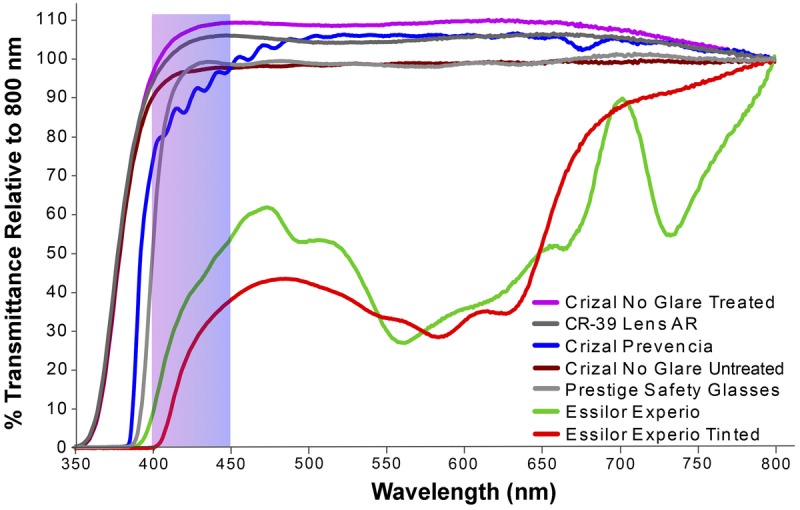
Ultraviolet/visible spectrophotometric scans comparing the percent transmission of group 4 (lens blanks and demo lenses). The wavelengths, 400 to 450 nm, are high-energy violet light that presents the greatest risk to ocular tissue. This spectral range is emphasized as a shaded area.
Group 5: Blue Blockers
Group 5 included sunglasses and blank lenses that are purposely designed and sold as lenses that block ultraviolet and “blue light.” Although all of the tested lenses blocked 100% ultraviolet light and 96% high-energy violet light up to 412 nm (Fig. 5), the BluBlocker sunglasses (BluBlocker Corporation, Las Vegas, NV) blocked 100% visible light up to 495 nm. Some efficiency in blue light blocking was shown by Noir UV Shield 22 sunglasses that blocked 100 to 74.3% high-energy violet light between 400 and 426 nm. The BluTech Hi Impact Indoor Anti-reflective lens (BluTech LLC, Alpharetta, GA) blocked 100 to 38.4% high-energy violet light between 400 and 426 nm, whereas the BluTech Hi Impact Outdoor Anti-reflective lens blocked 100 to 96.4% high-energy violet light between 400 and 426 nm. When compared between the BluTech Polycarbonate Indoor lens and the BluTech Polycarbonate Outdoor Polarized lens, the indoor lens blocked 100 to 52.2% high-energy violet light, whereas the outdoor lens blocked approximately 100 to 88.2% high-energy violet light in the 400- to 426-nm range. The Kodak Total Blue (clear and colorless; Kodak, Signet Armorlite, Inc., Carlsbad, CA) blocked 100% ultraviolet light and 100 to 89% high-energy violet light between 400 and 420 nm and 72.9% at 426 nm. In addition, the Kodak Total Blue lens allows for 90% or more transmittance of light for wavelengths greater than 450 nm.
FIGURE 5.
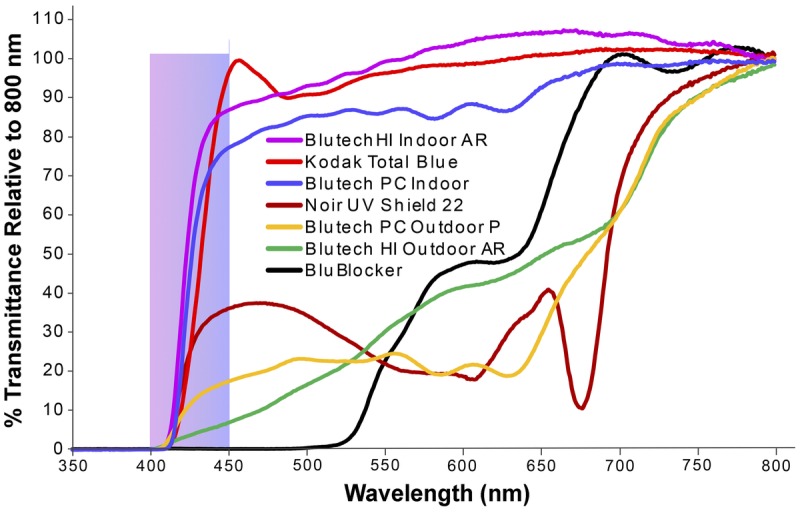
Ultraviolet/visible spectrophotometric scans comparing the percent transmission of group 5 (blue blocker lenses). The wavelengths, 400 to 450 nm, are high-energy violet light that presents the greatest risk to ocular tissue. This spectral range is emphasized as a shaded area.
Group 6: Clear Lens Series
Data from Figs. 4 and 5 were combined to produce Fig. 6, which highlights the high-energy violet light–blocking quality of various clear and colorless lenses. Kodak Total Blue blocked 100 to 89% high-energy violet light between 400 and 420 nm and 72.9% at 426 nm. Essilor Crizal Prevencia blocked only 25.4 to 8.3% high-energy violet light between 400 and 426 nm. Results for the other lenses are described previously in group 4 lens blanks series.
FIGURE 6.
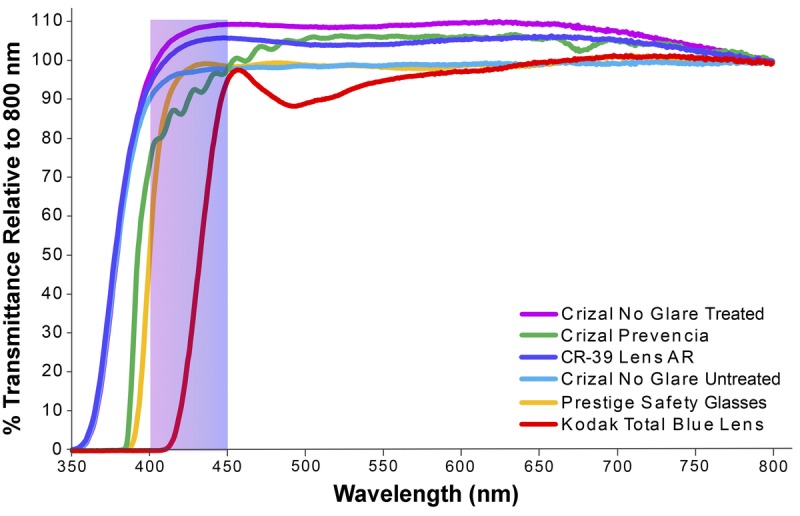
Ultraviolet/visible spectrophotometric scans comparing the percent transmission of group 6 (clear, colorless lenses). The wavelengths, 400 to 450 nm, are high-energy violet light that presents the greatest risk to ocular tissue. This spectral range is emphasized as a shaded area.
DISCUSSION
The danger from ultraviolet light is well known. High-energy violet light is being investigated increasingly as a hazard to ocular tissues.11,44 It may also be a risk factor for macular degeneration and other pathologies.19,49
Most glasses and sunglasses feature a plastic (polycarbonate and Trivex) lens, which inherently protects the eyes from ultraviolet light. Most sunglass lenses absorb ultraviolet radiation to 400 nm (ultraviolet B, 280 to 315 nm; ultraviolet A, 315 to 400 nm) owing to ultraviolet light stabilizers incorporated in the plastic. The ultraviolet absorbers (benzotriazoles and hydroxyphenyltriazines for polycarbonate) prevent deterioration of physical properties such as loss of impact strength, changes in color, cracking, crazing, and others.50
Protection from harmful ultraviolet light is assumed through international standards such as International Organization for Standardization 12311:2013 and 8980 and American National Standards Institute Z80.3 (2013 and 2015). The American ultraviolet light cutoff is 380 nm. Additional standards—European, Australian/New Zealand, Canadian, and Brazilian—are also available.51–53 The European ultraviolet light cutoff is 380 nm, whereas the Canadian, Australian/New Zealand, and Brazilian cutoff is 400 nm. All of the lenses tested in this study met the general standards specification of blocking 100% of ultraviolet A light less than 380 nm.
The present study was undertaken from the perspective of public health and “preventive measure,” to understand optimum lens optical filter properties that protect ocular tissues from photochemical damage. Similar studies have recently been conducted to assess sunglass filtering properties and relative cost.51,54,55 Our focus was to determine the spectral transmission properties of various sunglasses and eyeglass lenses and compare the wavelength cutoff gradient for those lenses.
The measurement of the actual amount of a particular wavelength of light falling onto or entering the eye and reaching the retina is complicated. Various factors such as relative lens tinting, side transmission of stray light, lens optical grinding (with resulting thickness variations), and the selected eyeglass frames and position of the lens over the eye impact the temporal size of the pupil, which determines the amount of light entering the eye. Because the pupil response is most sensitive to visible light, conventional sunglasses may allow for pupil dilation in proportion to the darkness of the sunglasses and increased intraocular insolation.56,57 Therefore, light transmission wavelength measurements of a specific lens material may not predict real-world conditions when the lens material is incorporated into the eyeglass or sunglass.
Sunglass and clear optical lenses may comprise several spectral bands of light filtration. The neutral density filtering property of each lens dictates the overall optical filtering that determines the lightness or darkness of the lens over the entire spectral range. Additional specific wavelength-dependent long-pass cutoff filter dyes and coatings determine the absolute light-blocking and light-transmitting characteristics below and above a specific wavelength. Light transmission through a light-absorbent material is also thickness dependent wherein a small thickness variation from lens optical grinding may dictate if a particular lens restricts a specific light wavelength below a specific limit.58
We electronically normalized the total light transmission to 100% at 800 nm so that a comparison of filtering properties between the various lenses, regardless of thickness or whether darkened or clear, could be made in the ultraviolet and high-energy blue range. Comparing a specific lens material filtration to 100% air transmission gives a total filtration report but convolutes the comparison between several lens materials because of overriding lightness or darkness of lenses. Some of the tested lens materials reported more than 100% or less than 0% transmission throughout the testing range of 800 to 350 nm.
Light transmission values at wavelengths different from the selected normalization wavelength (800 nm) may yield values higher or lower than the 100% transmission established at the normalization wavelength (800 nm). In other words, the lens filtering material and/or coating may allow for more or less light transmittance at wavelengths other than the normalization zeroing point of 100% light transmission at 800 nm.
Given that the objectives of this study were to be able to determine spectral wavelength cutoff and to compare lens to lens, we used a spectrophotometric measuring procedure that initiated each lens spectral scan at 800 nm, a wavelength that is color neutral and neutral density. Each lens was normalized or “zeroed” to itself. By following this protocol, all spectral scans of the tested lenses were initiated and normalized at the same beginning value. In addition, by scanning this way, the issue of spectral neutral density filtering (lightness/darkness) is normalized.
Our investigation of the ultraviolet and high-energy blue-violet light–blocking properties, provided by low-, medium-, and high-priced sunglasses, blue blocker, and clear lenses, yielded unexpected results. Although most tested lenses blocked ultraviolet A along with a fraction of high-energy violet light from entering the eye, a few high-priced branded sunglasses, including a few of the Ray-Ban sunglasses, did not filter the light as promoted. However, the low-priced promotional sunglasses (tinted polycarbonate) blocked 100% of the ultraviolet A light and 99.8 to 67% (400 to 450 nm, respectively) of the high-energy violet blue light. At 426 nm, the midrange of high-energy violet light, the promotional sunglasses blocked 72.5%. These values could be biased observations, as all the promotional sunglasses came from a single provider.
In comparison, three of the retail sunglasses provided 100% ultraviolet A light protection up to 400 nm. The Solar Shield Night Drivers blocked only 94.4% ultraviolet A light at 400 nm. However, when looking at the high-energy violet value of 450 nm, the three retail sunglasses provided only 63 to 75% blocking protection. The Solar Shield Night Drivers blocked 82.5% at 450 nm.
The tested designer sunglasses varied widely in their optical transmissibility with respect to their ultraviolet A and high-energy violet light–blocking properties, with some not blocking ultraviolet A. Two of the high-priced designer sunglasses, Costa Brine P and Maui Jim Peahi Redfish, blocked ultraviolet A light (100% at 400 nm) and approximately 90% high-energy violet at 450 nm, which is ideal for protecting eyes from light hazard. Our studies do not undermine the optical qualities of all of the expensive or branded sunglasses, as we are aware that expensive designer sunglasses vary widely in their construction, material, and surface protection coating.
Our observations of the blue blocker lenses varied as well. They all blocked 100% ultraviolet A light up to approximately 406 nm and blocked more than 90% of the high-energy violet light up to 414 nm. Clear and colorless Kodak Total Blue provided approximately 73% high-energy violet light protection at 426 nm, whereas clear and colorless Essilor Crizal Prevencia provided only 8.3% high-energy violet protection at 426 nm. To their benefit, the manufacturer claims that such small narrow-band protection of the Essilor Crizal Prevencia is intentionally done to maintain transparency and good color vision perception through the lenses. It is also interesting to note that both tinted promotional sunglasses and clear and colorless Kodak Total Blue blocked 73% of the high-energy violet light at 426 nm.
The sensitivity of the human eye to light, shown in Fig. 7, varies strongly over the wavelength range between 380 and 800 nm.60 The average normal human eye, under daylight conditions, is most sensitive at a wavelength of 555 nm and less responsive to red, greater than 670 nm, and blue wavelengths, less than 430 nm, suggesting that filtration of wavelengths less than 430 nm should have little impact on perceived color vision.
FIGURE 7.
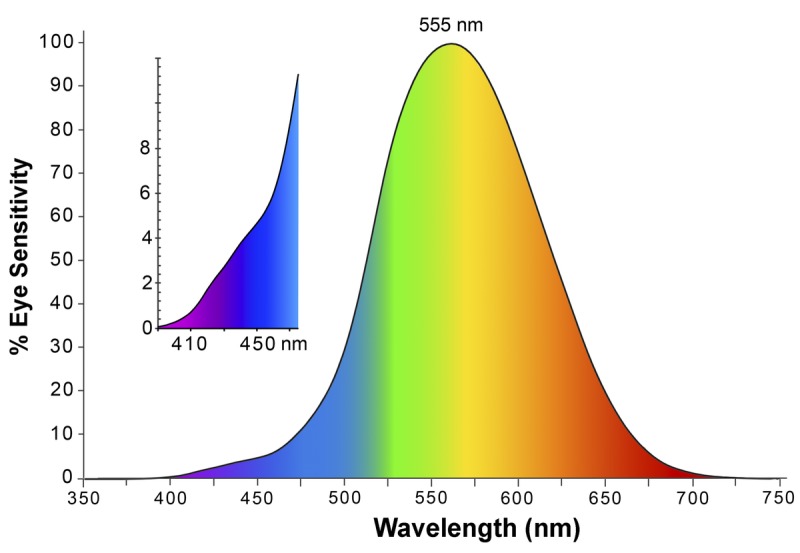
Eye sensitivity function. Photopic eye sensitivity function has a maximal sensitivity in the green spectral range at 555 nm. The inset shows the blue light region, 400 to 480 nm. Drawn from Vos.59
Removal of 94% of the blue component of light, 400 to 500 nm, has been shown to decrease retinal damage.18 We suggest that eyeglasses and sunglasses filter 100% of all ultraviolet and high-energy violet light up to 426 nm with a lessening gradient to 450 nm. One such available product is the Bluwinx lens (Bluwinx, Youngstown, OH). These lenses filter 71% of the 400- to 500-nm spectrum, with around 59% of the peak digital device wavelengths (445 to 460 nm). Other available lenses/coatings are UV420 Clear Lens (Mitsui Chemicals, Tokyo, Japan), Duravision BlueProtect (Zeiss, Aalen, Germany), Bluemax Lens (Nova, Vision Rx Lab, Kolkata, India), and Blue Diamond coating (Visioneer Eyewear, Pasay City, Philippines).
Sunglasses are usually recommended as protection against sunlight and glare, and conventional sunglasses are considered a fashion accessory. Electronic digital devices with light-emitting diode screens are becoming major sources of such high-energy violet exposure indoors. Evidence is mounting that chronic exposure of the visible blue light can cause oxidative damage to the ocular tissues.20,61 Further investigation is necessary to identify the quantity of short-wavelength light required for a physiologically functional balance, without causing damage to ocular tissues.
Because optical properties greater than 380 nm are not addressed in the U.S. standards for ultraviolet protection, eye care providers need to provide information and educate the general public, to correctly purchase sunglasses or high-energy violet light–protective clear lenses. Testing devices that measure blue light–blocking lenses or self-service kiosks for testing sunglasses are being developed,52,62 and we suggest that retail stores selling eyewear provide access to ultraviolet/visible lens spectrographs to assess the quality of eyewear.
We recommend that there be a standardization of procedure and method for the assessment of a lens' spectral transmission in order for eye care providers to objectively compare eyeglass lens filtering capacity. We suggest the methods used in this study to be an example of a uniform way to measure lenses (eyeglasses and sunglasses) to negate the issue of brightness/darkness, as well as negate the issues of lens material and thickness. Determination of the spectral wavelength cutoff provides important information on the ultraviolet and high-energy violet light–blocking capability of each lens tested. By using this information, eye care providers can be better informed and then be able to recommend the best lens for the patient and the intended use, whether it is indoor or outdoor.
CONCLUSIONS
This study emphasizes the need for individual eyewear and sunglass assessment before the consumer purchases the eyeglasses or sunglasses. Expensive designer eyewear may not necessarily possess the adequate eye protection that the consumer assumes the product provides. Designer fashion and high-retail-price eyewear should not dominate the decision process of purchasing eyewear without spectral testing. In fact, more harm may come from wearing poor-quality sunglasses rather than just wearing clear polycarbonate lenses.
Based on the current literature and our study results, we suggest that an ideal pair of sunglasses should be able to block 100% of ultraviolet A and high-energy violet-blue wavelengths (400 to 450 nm) and transmit the long-wavelength blue light to preserve color perception and scotopic sensitivity and maintain sleep-wake cycle. For indoor use, our studies suggest choosing clear, colorless high-energy violet/blue blocker eyewear for use with light-emitting diode–related digital devices and computer screens.
Supplementary Material
Footnotes
Supplemental Digital Content: Appendix Table A1. Percent spectral transmission data obtained from spectrophotometer scans, for each lens group, as described in METHODS, at wavelengths 400 to 450 nm. Available at http://links.lww.com/OPX/A405.
Funding/Support: None of the authors have reported funding/support.
Conflict of Interest Disclosure: None of the authors have reported a financial conflict of interest.
Author Contributions: Conceptualization: LJL; Data Curation: SAG, ERK; Formal Analysis: SAG, ERK; Investigation: SAG, ERK; Methodology: SAG, ERK; Resources: ERK, LJL, PKG; Supervision: PKG; Writing – Original Draft: SAG, ERK; Writing – Review & Editing: SAG, ERK.
Supplemental Digital Content: Direct URL links are provided within the text.
REFERENCES
- 1.Lucas RM, Repacholi MH, McMichael AJ. Is the Current Public Health Message on UV Exposure Correct? Bull World Health Organ 2006;84:485–91. [DOI] [PMC free article] [PubMed] [Google Scholar]
- 2.Roberts JE. Ocular Phototoxicity. J Photochem Photobiol B 2001;64:136–43. [DOI] [PubMed] [Google Scholar]
- 3.Majdi M, Milani B, Movahedan A, et al. The Role of Ultraviolet Radiation in the Ocular System of Mammals. Photonics 2014;1:347. [Google Scholar]
- 4.Behar-Cohen F, Baillet G, de Ayguavives T, et al. Ultraviolet Damage to the Eye Revisited: Eye-Sun Protection Factor (E-SPF®), a New Ultraviolet Protection Label for Eyewear. Clin Ophthalmol 2014;8:87–104. [DOI] [PMC free article] [PubMed] [Google Scholar]
- 5.Haigh JD. The Sun and the Earth's Climate. Living Rev Sol Phys 2007;4:2. [Google Scholar]
- 6.Sliney DH. How Light Reaches the Eye and Its Components. Int J Toxicol 2002;21:501–9. [DOI] [PubMed] [Google Scholar]
- 7.Dillon J, Zheng L, Merriam JC, et al. The Optical Properties of the Anterior Segment of the Eye: Implications for Cortical Cataract. Exp Eye Res 1999;68:785–95. [DOI] [PubMed] [Google Scholar]
- 8.Begaj T, Schaal S. Sunlight and Ultraviolet Radiation—Pertinent Retinal Implications and Current Management. Surv Ophthalmol 2018;63:174–92. [DOI] [PubMed] [Google Scholar]
- 9.Ambach W, Blumthaler M, Schöpf T, et al. Spectral Transmission of the Optical Media of the Human Eye with Respect to Keratitis and Cataract Formation. Doc Ophthalmol 1994;88:165–73. [DOI] [PubMed] [Google Scholar]
- 10.Arnault E, Barrau C, Nanteau C, et al. Phototoxic Action Spectrum on a Retinal Pigment Epithelium Model of Age-related Macular Degeneration Exposed to Sunlight Normalized Conditions. PLoS One 2013;8. [DOI] [PMC free article] [PubMed] [Google Scholar]
- 11.Godley BF, Shamsi FA, Liang FQ, et al. Blue Light Induces Mitochondrial DNA Damage and Free Radical Production in Epithelial Cells. J Biol Chem 2005;280:21061–6. [DOI] [PubMed] [Google Scholar]
- 12.Ebert S, Walczak Y, Reme C, et al. Microglial Activation and Transcriptomic Changes in the Blue Light–exposed Mouse Retina. Adv Exp Med Biol 2012;723:619–32. [DOI] [PubMed] [Google Scholar]
- 13.Hammond BR, Johnson BA, George ER. Oxidative Photodegradation of Ocular Tissues: Beneficial Effects of Filtering and Exogenous Antioxidants. Exp Eye Res 2014;129:135–50. [DOI] [PubMed] [Google Scholar]
- 14.Kuse Y, Ogawa K, Tsuruma K, et al. Damage of Photoreceptor-derived Cells in Culture Induced by Light Emitting Diode–derived Blue Light. Sci Rep 2014;4:5223. [DOI] [PMC free article] [PubMed] [Google Scholar]
- 15.Osborne NN, Li GY, Ji D, et al. Light Affects Mitochondria to Cause Apoptosis to Cultured Cells: Possible Relevance to Ganglion Cell Death in Certain Optic Neuropathies. J Neurochem 2008;105:2013–28. [DOI] [PubMed] [Google Scholar]
- 16.Krigel A, Berdugo M, Picard E, et al. Light-induced Retinal Damage Using Different Light Sources, Protocols and Rat Strains Reveals Led Phototoxicity. Neuroscience 2016;339:296–307. [DOI] [PubMed] [Google Scholar]
- 17.Shang YM, Wang GS, Sliney DH, et al. Light-emitting-diode Induced Retinal Damage and Its Wavelength Dependency in Vivo. Int J Ophthalmol 2017;10:191–202. [DOI] [PMC free article] [PubMed] [Google Scholar]
- 18.Vicente-Tejedor J, Marchena M, Ramirez L, et al. Removal of the Blue Component of Light Significantly Decreases Retinal Damage After High Intensity Exposure. PLoS One 2018;13. [DOI] [PMC free article] [PubMed] [Google Scholar]
- 19.Modenese A, Gobba F. Macular Degeneration and Occupational Risk Factors: A Systematic Review. Int Arch Occup Environ Health 2019;92:1–11. [DOI] [PMC free article] [PubMed] [Google Scholar]
- 20.Yamauchi K, Nakazawa M, Kato C, et al. Transient Macular Damage During Smartphone Usage. Curr Trends Ophthalmol 2018;1:71–4. [Google Scholar]
- 21.Shevell SK, ed. The Science of Color, 2nd ed Boston: Elsevier; 2003. [Google Scholar]
- 22.Smick K, Villette T, Boulton ME, et al. Blue Light Hazard: New Knowledge, New Approaches to Maintaining Ocular Health. Report of a Round Table. Dallas, TX: Essilor of America; 2013. [Google Scholar]
- 23.Klein R, Klein BE, Knudtson MD, et al. Fifteen-year Cumulative Incidence of Age-related Macular Degeneration: The Beaver Dam Eye Study. Ophthalmology 2007;114:253–62. [DOI] [PubMed] [Google Scholar]
- 24.Wong IY, Koo SC, Chan CW. Prevention of Age-related Macular Degeneration. Int Ophthalmol 2011;31:73–82. [DOI] [PMC free article] [PubMed] [Google Scholar]
- 25.Burkhart K, Phelps JR. Amber Lenses to Block Blue Light and Improve Sleep: A Randomized Trial. Chronobiol Int 2009;26:1602–12. [DOI] [PubMed] [Google Scholar]
- 26.van der Lely S, Frey S, Garbazza C, et al. Blue Blocker Glasses as a Countermeasure for Alerting Effects of Evening Light–emitting Diode Screen Exposure in Male Teenagers. J Adolesc Health 2015;56:113–9. [DOI] [PubMed] [Google Scholar]
- 27.Lin JB, Gerratt BW, Bassi CJ, et al. Short-wavelength Light-blocking Eyeglasses Attenuate Symptoms of Eye Fatigue. Invest Ophthalmol Vis Sci 2017;58:442–7. [DOI] [PubMed] [Google Scholar]
- 28.Leung TW, Li RW, Kee CS. Blue-light Filtering Spectacle Lenses: Optical and Clinical Performances. PLoS One 2017;12. [DOI] [PMC free article] [PubMed] [Google Scholar]
- 29.Colombo L, Melardi E, Ferri P, et al. Visual Function Improvement Using Photocromic and Selective Blue-violet Light Filtering Spectacle Lenses in Patients Affected by Retinal Diseases. BMC Ophthalmol 2017;17. [DOI] [PMC free article] [PubMed] [Google Scholar]
- 30.Shechter A, Kim EW, St-Onge MP, et al. Blocking Nocturnal Blue Light for Insomnia: A Randomized Controlled Trial. J Psychiatr Res 2018;96:196–202. [DOI] [PMC free article] [PubMed] [Google Scholar]
- 31.Fletcher AE, Bentham GC, Agnew M, et al. Sunlight Exposure, Antioxidants, and Age-related Macular Degeneration. Arch Ophthalmol 2008;126:1396–403. [DOI] [PubMed] [Google Scholar]
- 32.Lawrenson JG, Hull CC, Downie LE. The Effect of Blue-light Blocking Spectacle Lenses on Visual Performance, Macular Health and the Sleep-wake Cycle: A Systematic Review of the Literature. Ophthal Physiol Opt 2017;37:644–54. [DOI] [PubMed] [Google Scholar]
- 33.Tosini G, Ferguson I, Tsubota K. Effects of Blue Light on the Circadian System and Eye Physiology. Mol Vis 2016;22:61–72. [PMC free article] [PubMed] [Google Scholar]
- 34.Leid J. Blue Light: What Are the Risks to Our Eyes? Points de Vue: International Review Ophthalmic Optics 2016;1–7. Available at: https://www.pointsdevue.com/sites/default/files/blue-light-what-are-the-risks-to-our-eyes-final_0.pdf. Accessed April 2, 2019. [Google Scholar]
- 35.Marshall J. The Blue Light Paradox: Problem or Panacea? Points de Vue: International Review Ophthalmic Optics 2017:1–8. Available at: https://www.pointsdevue.com/sites/default/files/the_blue_light_paradox_problem_or_panacea_0.pdf. Accessed April 2, 2019. [Google Scholar]
- 36.Lucas RJ, Peirson SN, Berson DM, et al. Measuring and Using Light in the Melanopsin Age. Trends Neurosci 2014;37:1–9. [DOI] [PMC free article] [PubMed] [Google Scholar]
- 37.Figueiro M, Nagare R, Price L. Non-visual Effects of Light: How to Use Light to Promote Circadian Entrainment and Elicit Alertness. Light Res Technol 2018;50:38–62. [DOI] [PMC free article] [PubMed] [Google Scholar]
- 38.Bonmati-Carrion MA, Arguelles-Prieto R, Martinez-Madrid MJ, et al. Protecting the Melatonin Rhythm through Circadian Healthy Light Exposure. Int J Mol Sci 2014;15:23448–500. [DOI] [PMC free article] [PubMed] [Google Scholar]
- 39.Tahkamo L, Partonen T, Pesonen AK. Systematic Review of Light Exposure Impact on Human Circadian Rhythm. Chronobiol Int 2018;1–20. [DOI] [PubMed] [Google Scholar]
- 40.Youssef PN, Sheibani N, Albert DM. Retinal Light Toxicity. Eye (Lond) 2011;25:1–14. [DOI] [PMC free article] [PubMed] [Google Scholar]
- 41.Wu JM, Seregard S, Algvere PV. Photochemical Damage of the Retina. Surv Ophthalmol 2006;51:461–81. [DOI] [PubMed] [Google Scholar]
- 42.van Norren D, Vos JJ. Light Damage to the Retina: An Historical Approach. Eye (Lond) 2016;30:169–72. [DOI] [PMC free article] [PubMed] [Google Scholar]
- 43.Sui GY, Liu GC, Liu GY, et al. Is Sunlight Exposure a Risk Factor for Age-related Macular Degeneration? A Systematic Review and Meta-analysis. Br J Ophthalmol 2013;97:389–94. [DOI] [PubMed] [Google Scholar]
- 44.Marie M, Bigot K, Angebault C, et al. Light Action Spectrum on Oxidative Stress and Mitochondrial Damage in A2e-loaded Retinal Pigment Epithelium Cells. Cell Death Dis 2018;9:287. [DOI] [PMC free article] [PubMed] [Google Scholar]
- 45.Moseley H. Ultraviolet and Visible Radiation Transmission Properties of Some Types of Protective Eyewear. Phys Med Biol 1985;30:177–81. [DOI] [PubMed] [Google Scholar]
- 46.Moseley H, Cox NH, Mackie RM. The Suitability of Sunglasses Used by Patients Following Ingestion of Psoralen. Br J Dermatol 1988;118:247–53. [DOI] [PubMed] [Google Scholar]
- 47.Reichow AW, Citek K, Edlich RF. Ultraviolet and Short Wavelength Visible Light Exposure: Why Ultraviolet Protection Alone Is Not Adequate. J Long Term Eff Med Implants 2006;16:315–25. [DOI] [PubMed] [Google Scholar]
- 48.Chorley AC, Lyachev A, Higlett MP, et al. Sunglass Filter Transmission and Its Operational Effect in Solar Protection for Civilian Pilots. Aerosp Med Hum Perform 2016;87:436–42. [DOI] [PubMed] [Google Scholar]
- 49.Hunter JJ, Morgan JI, Merigan WH, et al. The Susceptibility of the Retina to Photochemical Damage from Visible Light. Prog Retin Eye Res 2012;31:28–42. [DOI] [PMC free article] [PubMed] [Google Scholar]
- 50.Xanthopoulos P. UV Stabilizers for Engineering Plastics. Omnexus by SpecialChem Plastics Selection Guide. Available at: https://omnexus.specialchem.com/selection-guide/uv-stabilizers-for-engineering-plastics/uv-stabilizers-for-polycarbonate#. Accessed April 11, 2018.
- 51.Trang N, Lalonde G, Dube Y, et al. Short Wavelengths Filtering Properties of Sunglasses on the Canadian Market: Are We Protected? Can J Ophthalmol 2018;53:104–9. [DOI] [PubMed] [Google Scholar]
- 52.Mello MM, Lincoln VA, Ventura L. Self-service Kiosk for Testing Sunglasses. Biomed Eng Online 2014;13:45. [DOI] [PMC free article] [PubMed] [Google Scholar]
- 53.Masili M, Schiabel H, Ventura L. Contribution to the Radiation Protection for Sunglasses Standards. Radiat Prot Dosimetry 2015;164:435–43. [DOI] [PubMed] [Google Scholar]
- 54.Gursoy H, Basmak H, Esen H, et al. Transmittance Spectrum of Unbranded Sunglasses Using Spectrophotometer. Open J Ophthalmol 2015;5:1–5. [Google Scholar]
- 55.Bingemann D, Mattley Y. Labmate. Sun, Safety, Spectroscopy—The Science of UV Measurement and Assessing Sun Protection; 2016. Available at: https://www.labmate-online.com/article/mass-spectrometry-and-spectroscopy/41/dieter_bingemann_yvette_mattley/sun_safety_spectroscopy_-_the_science_of_uv_measurement_and_assessing_sun_protection/2097. Accessed April 2, 2019.
- 56.Sliney DH. Photoprotection of the Eye—UV Radiation and Sunglasses. J Photoch Photobiol B 2001;64:166–75. [DOI] [PubMed] [Google Scholar]
- 57.Coroneo M. Ultraviolet Radiation and the Anterior Eye. Eye Contact Lens 2011;37:214–24. [DOI] [PubMed] [Google Scholar]
- 58.Ozdemir T, Saglam A, Ozdemir FB, et al. The Evaluation of Spectral Transmittance of Optical Eye-lenses. Optik 2016;127:2062–8. [Google Scholar]
- 59.Vos JJ. Colorimetric and Photometric Properties of a 2° Fundamental Observer. Color Res Appl 1978;3:125–8. [Google Scholar]
- 60.Wyszecki G, Stiles WS. Color Science: Concepts and Methods, Quantitative Data, and Formulae. Wiley Classics Library ed New York: John Wiley & Sons; 2000. [Google Scholar]
- 61.Martin CW. Blue Light from Digital Screens at Work: A Rapid Systematic Review. In: WorkSafeBC Evidence-Based Practice Group, Martin CW, ed. Blue Light from Digital Screens Used at Work Richmond, BC: WorksafeBC Evidence-Based Practice Group; 2018. Available at: https://www.worksafebc.com/en/resources/health-care-providers/guides/blue-light-from-digital-screens-used-at-work?lang=en&origin=s&returnurl=https%3A%2F%2Fwww.worksafebc.com%2Fen%2Fsearch%23q%3Ddigital%2520screens%26sort%3Drelevancy%26f%3Alanguage-facet%3D%5BEnglish%5D. Accessed January 29, 2019. [Google Scholar]
- 62.Chen DC, Huang KL, Lee SL, et al. Blue Light Blocking Lenses Measuring Device. Procedia Eng 2016;140:17–29. [Google Scholar]
Associated Data
This section collects any data citations, data availability statements, or supplementary materials included in this article.


